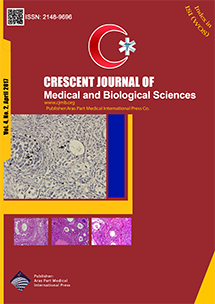
| Original Article | |
| Impact of Empirical Antibiotic Treatment Duration on Short-term Prognosis of Very Low Birth Weight Newborns | |
| Mohammad Bagher Hosseini1, Majid Mahallei1, Bahareh Mehramuz2, Meysam Behtari3, Pegah Alemi1, Shahram Abdoli Oskouee1, Zakeiye Salimi4, Haniyeh Sakha1 | |
| 1Pediatric Health Research Center of Tabriz, Department of Pediatrics and Neonatology, Tabriz University of Medical Sciences, Tabriz, Iran 2Department of Pathology, Alzahra Teaching Hospital, Tabriz University of Medical Sciences, Tabriz, Iran 3rsity of Tabriz, Tabriz, Iran 4Neonatal Intensive Care Unit, Alzahra Teaching Hospital, Tabriz University of Medical Sciences, Tabriz, Iran |
|
|
CJMB 2017; 4: 059-063 Viewed : 5639 times Downloaded : 4480 times. Keywords : Premature infants, Very low birth weight infants, Antibiotic treatment, Early onset sepsis |
|
| Full Text(PDF) | Related Articles | |
| Abstract | |
Objective: Probable early infection is one of the most important reasons to begin antibiotics treatment for very low birth weight (VLBW) infants. In most of the cases, antibiotics treatment continues as long as the venous line persist. Long-term empirical antibiotics therapy for premature infants (5 days) create even more danger than the infection itself, such as necrotizing enterocolitis (NEC) and death. In order to reduce the risks of these dangers, antimicrobial therapy must stop in clinical conditions in which the possibility of infection is low. This study makes an effort to evaluate the impact of empirical antibiotic treatment duration on early prognosis of premature infants with VLBW. Materials and Methods: A total of 209 premature infants with birth weight less than 1500 g who were suspicious of having infection, were evaluated in 2 groups of control (107 infants) and intervention (102 infants). All of the infants evaluated for sepsis according to the protocol of the unit. In the control group, antibiotics treatment continued as long as the venous line persist, in the intervention group after day 3 to 5 if the results of blood culture were negative, the infants were checked for C-reactive protein (CRP), and if it was negative too and the patient’s clinical status was good, antibiotic treatment was stopped. The outcome measures were short-term prognosis of with VLBW newborns. Results: The mean gestational age of the studied patients was 30.21 ± 2.69 and 29.57 ± 2.09 g in the control and intervention groups, respectively (P = 0.07). The average days of receiving antibiotics in the control group were 29.21 ± 1.57 while in the intervention group it was 8.11 ± 2.16 (P < 0.001). Our study suggests that duration of hospitalization (P < 0.001), need for mechanical ventilation (P < 0.001) and duration of use of high-flow nasal cannula (HFNC) (P = 0.04), blood products transfusion (P = 0.007), length of stay in hospital (P < 0.001) were dramatically decreased in intervention group comparing to control group. Rate of later sepsis work-ups was decreased as well. But, in other findings such as need for continues positive airway pressure (CPAP), parenteral nutrition, mortality rate, need for resuscitation and rate of urinary tract infection, no meaningful difference were found between two groups (P > 0.05). Conclusion: Early discontinuing of antibiotics (5 days or less) had no impact on the mortality rate of VLBW infants and seemed it was safe. |
Cite By, Google Scholar
Google Scholar
PubMed
Online Submission System
 CJMB ENDNOTE ® Style
CJMB ENDNOTE ® Style
 Tutorials
Tutorials
 Publication Charge
Medical and Biological Research Center
About Journal
Publication Charge
Medical and Biological Research Center
About Journal
Aras Part Medical International Press Editor-in-Chief
Arash Khaki
Deputy Editor
Zafer Akan


















